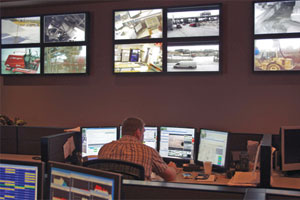
|
|
A unique video wall at central dispatch of Ozinga Ready Mix Concrete empowers staff to monitor company operations at numerous locations. |
Walk the floor at ISC West and you see how far security video has come. But there are some developments that go beyond the typical.
One nugget is at Jerry’s Nugget, the Greek-American family business that sells olive oil imported from a homeland region and, by the way, is the historic casino in Las Vegas. The property is uniquely going all-megapixel cameras, with the approval of the gaming board. “It’s a demanding environment,” Marco Vogt of Basler Vision Technologies tells me. “You have to have 30 frames per second in the low light conditions of casino floors.” In addition to showing off his technology at Jerry’s Nugget, Vogt’s ISC booth will spotlight a new line of IP fixed dome cameras alongside its box cameras.
There’s another twist in the technology. “Firmware enables configuration of up to four image streams using any encoder type combination. In a parking lot for example, from one camera’s total field of view you can get up to four selected view streams,” says Vogt.
Security Video is a Bonus
Unique technology is also pouring it on at Ozinga Ready Mix Concrete, where a video wall lets central dispatchers view multi-site operations at 27 locations that serve Chicago, suburban Illinois and northwest Indiana. Dispatch services have been consolidated into a “fourth generation” facility, boasting global positioning system vehicle tracking and computerized order entry.
The wall in front of the 30 dispatcher workstations, reminiscent of a NASA control center, is covered with two dozen 42-inch flat screen monitors – two dozen of them in all – for real-time video images of what’s happening across the operation. Video management software from OnSSI ties together video feeds from 56 diversely located cameras. Any dispatcher can locate a truck or a conveyor, to confirm that equipment is in a location, or to get a general idea of inventory based on video of big piles of rock and sand and silos of cement.
“We wanted to put the information that is common to all the dispatchers, including the video views of various parts of the operation, on the wall so everyone could see it without taking up desk space,” says Tom Allen, director of information technology for Ozinga. OnSSI’s virtual video matrix switch supplies video to the LCD screens. It enables any camera view to be sent to any display screen using a user-friendly, touch-screen interface that requires minimal training. Video can be securely monitored, recorded, administered and accessed from any authorized workstation or portable device within the local network or over the Internet.
Ozinga, the largest family-owned ready-mix concrete manufacturer in North America, has sites typically in heavy industrial areas or in emerging locations. Video travels across the corporate virtual private network using available T1 or DSL lines. The network also carries order and manufacturing information, neither of which takes up much bandwidth though both receive priority. Video bandwidth can be easily adjusted as necessary. The firm uses a mix of cameras from Canon, Sony and Axis Communications, the latter’s encoders transition some analogs to the networked platform.
Very fine cement dust was an environmental challenge, so Ozinga has migrated to pressurized domes to protect them from the dust. Pan-tilt-zoom functionality for at least one camera at each site is integrated with the system. Most of the PTZs are used with presets. Placement of cameras was decided in-house, using trial and error and learning as they went. “The dispatchers say we need to see this or that, and we know right where to look,” comments Allen. He says the system was installed by “an eager, learn-as-you-go, overachieving, do-it-yourself IT department that loves new technology and challenges.”
Three video card-equipped Hewlett Packard servers each provide output to eight screens. The system also includes a server installed on 60 or so computers, including those in management offices and in remote locations in addition to the dispatch center. At Ozinga, there are no restrictions on who can view video.
“Our cameras are primarily used for process monitoring in the live view,” adds Allen. “Product demand changes constantly at our plants, so getting the right video feeds is important. This is a perfect example of how video is very important to the manufacturing process for us,” he says. “Security is important, too, but for us, the need for security is much less than manufacturing, which happens every day all day. To have eyes on that is great, and it’s to the point now that I don’t know what we would do without it.”

